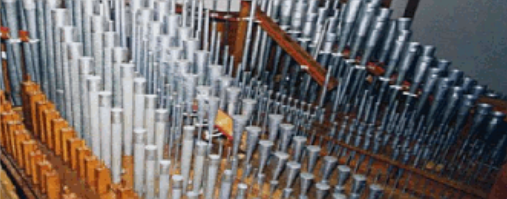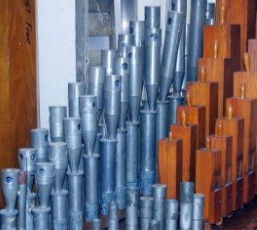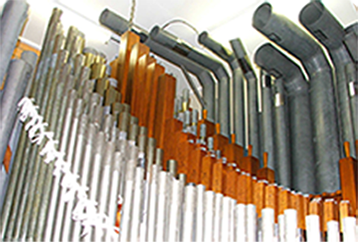
If you have ever examined a Theatre Pipe Organ specification, you will note that different ranks can be composed of different numbers of pipes. Why is this so?
If we examine organ keyboards (manuals) we find that the standard compass is 61 keys (as opposed to a traditional acoustic piano, which has 88 keys).
If we start at Middle C near the center of the keyboard, and play all the white notes in ascending order, we will be playing up the scale in the key of C Major. The familiar do=C, re=D, me=E, fa=F, so=G, la=A, ti=B, do=C. If you count the notes from the starting C to the higher C, you will find that there are eight. Thus the use of the term “octave” to describe the segments of notes that are repeated up and down the keyboard (at higher or lower pitches). The C we ended at is said to be one octave higher than the one we started at.
So, it stands to reason that the number of pipes in a rank must be related to multiples of 8, correct? WRONG! It is a bit confusing! Let’s go back to our C Major scale. We play 7 notes (C,D,E,F,G,A,B,), not 8, before we start to repeat. (The eighth note is C, the first note of the next octave.) OK, so the number of pipes in a rank must be related to multiples of 7, correct? SORRY, CHARLIE, WRONG AGAIN! Since we are playing the scale in the key of C Major, we have neglected to count any of the black keys, the “sharps” and “flats”. Examine an octave on the keyboard and you will find 5 black keys (C#=Db, D#=Eb, F#=Gb, G#=Ab, and A#=Bb). If you played all keys (white and black) as you ascended up from middle C, you would be playing the “chromatic” scale. With 7 white keys in an octave and 5 black keys, the number of pipes in a rank must be related somehow to multiples of 12, correct? ABSOLUTELY RIGHT!
O.K, lets go back and take a look at our organ keyboards. We find that the lowest note on the manual is a C, and we note that there are two full octaves below middle C. Examining further, we find that there are three full octaves above middle C, but that the highest note on the keyboard is a C (ie the first note of another octave). Now we have counted 5 full octaves of 12 notes each, plus the high C. 5 octaves times 12 notes per octave=60, plus 1=61 notes, VOILA!
So, each rank in a Theatre Pipe Organ must be composed of 5 12 note octaves plus the high C, or 61 pipes, correct? NOT QUITE.
Let’s stop here and define pipe organ “footage” nomenclature. The foot designation printed on an organ stop tab is related to the length of the lowest pipe on the keyboard. Thus an 8’ stop is composed of 61 pipes, the longest in length (a C played at the bottom of the keyboard) being approximately 8’ long. The lowest pipe on the keyboard of a 4’ stop is approximately 4’ long, of a 16’ stop is 16’ long, etc (the lengths halve or double – 1’,2’,4’,8’,16’,32’, 64’)
Let’s say you sit down at a console and select an 8’ Vox Humana stop. Every one of the 61 notes will play at “unison” pitch (the same as on an acoustic piano), necessitating 61 pipes. Now, let’s say the same organ has a 4’ Vox Humana stop available on one or more of the manuals. Select this stop and all notes will sound 1 octave higher than unison. If the rank only had 61 pipes, the topmost 12 notes on the keyboard would not be able to play. Thus to offer the Vox Humana ALSO at a 4’ pitch, the organ builder has to add 12 more small pipes at the top of the scale. The rank would consist of 6 octaves of 12 pipes=72, plus high C = 73 pipes. (When playing the 4’ stop, the lowest 12 pipes would go unused, and when playing the 8’ stop, the highest 12 pipes would go unused).
The same thing works going in the other direction. Let’s say you have a stop which the organ builder wants to make available at 8’= unison pitch, 4” = one octave higher, and 16’ = one octave lower. To include the bottom octave on the keyboard when the 16’ stop is selected, 12 more large pipes are required. Thus we would need 7 octaves of 12 pipes plus high C, or 7 times 12=84, plus high C = 85 pipes.
The compass of a standard pedalboard is 32 notes or two and a fraction octaves (The notes are the same as the lowest 32 notes on the manuals). With so few notes, the pedalboard utilizes no more pipes than the manuals, and thus is incidental to our mathematics of pipes in a rank.

Using the math above, we can create a chart to determine the number of pipes in a rank.
Number of Octaves
of Sound
5
6
7
8
Number
of Pipes
61
73
85
97
Number of pitches available (2’, 4’,8’,16’, etc)
1
2
3
4
There are exceptions to our chart however. If we take the Loew’s Jersey Wonder Morton as an example, the specifications include a “Concert Violin TC” with 73 pipes, available at 3 pitches – 16’, 8’, and 4’ (not two pitches). How can this be? Shouldn’t there be 85 pipes? The answer is in the “TC” designation. It stands for “Tenor C”. When you see this designation on the 16’ stop tab, it indicates that the organ builder has not added the 12 pipes to cover the lowest octave on the keyboard below “Tenor C” when the 16’ stop is selected. Those keys will simply not sound.
Another exception concerns the Wurlitzer company. In many of their organs (when it was not otherwise specified by the buyer), they would offer a stop such as the Vox Humana at 8’ and 4’ pitches, but only build a 61 pipe rank. The additional 12 pipes at the top of the scale needed to complete the 4’ pitch were not added, “hoping” that the organist would never use the top 12 keys on the keyboards when playing the 4’ stop.
Given all of the above, we can now better understand why organs contain “offset chests” as defined earlier. Let’s say for example, that an organ chest holds 3 ranks of 61 pipes each. From our math we know that each rank on that chest will be available at one pitch. But what if the organ builder wants two pitches available for one of the ranks? He simply provides a separate “offset chest” for 12 additional pipes for that rank.
One last note: tuned percussions (xylophone, glockenspiel, marimba, chimes, sleigh bells, chrysoglott, etc.) generally offer far fewer notes than the 61 available on the keyboards. They play in the center of the manuals at the pitches they normally would play at in an orchestra. If you try to play higher or lower on the keyboards, you will encounter dead notes! There is one exception, however. When an acoustic piano with its 88 keys is attached to an organ, all 61 keys on the manuals will play the corresponding piano notes.










